-
StrateGene
review on March 28, 2017
by Ellen Hinkley

At a Glance
Summary
In summary, whilst I can see that this report had many merits, particularly in its detail, supporting evidence and excellent diagrams, I felt that it was a bit too complex to be of real use. I’d recommend this test to those who have a keen interest in the scientific analysis involved in DNA testing, rather than to those who would prefer easily understandable results and readily implementable recommendations. The report definitely provided extra information about my 23andMe data and gave me a lot of good starting points from which to base further research. This said, in general I think this report is much better suited to those with a medical or scientific background than consumers.
Full Review
StrateGene is one of an increasing number of services that offer to provide different or additional interpretations of your 23andMe raw DNA data. The StrateGene report is focused on ‘Genetic Pathway Analysis’ and focusses on the biochemical processes in your body that relate to and may affect your health. They don’t use all of your 23andMe data, instead choosing to focus on a few genetic variants that they’ve identified as clinically relevant. This is all done with the aim of simplifying the results by focusing on a few specific genes, helping you to improve your lifestyle via holistic methods.
Product expectations
The StrateGene website included a lot of background information about the results I would receive as part of the report. This information was mainly provided in a series of videos featuring the man behind StrateGene, Dr Ben Lynch. The way in which the details of the report were provided was often in the context of other similar reports, and how StrateGene was a better choice. The videos seemed to have been modelled on academic lectures, which was quite effective, along with the fact that a doctor was presenting them. I have to admit I felt more trusting of the report than others by the time I had finished watching them.
As well as the videos, there was a list of the genetic polymorphisms or SNPs that would be analyzed to produce the report. These were sorted into ‘Core’ and ‘Bonus’ SNPs. I wasn’t quite sure why some were considered as core and some as bonus ones, especially as there was an accompanying note that stated, “We've filtered out the non-essential so you can spend more time on the essential!”.
In addition, there was a list of positive reviews which included comments from doctors and members of the public. This made sense, as it was made clear that the report was aimed to cater for both groups. There were finally four short points which summarized what was included in the review. These indicated quickly that the report was likely to be quite scientific, as phases such as ‘kinetic impact’ were included. I was impressed to see that the report would include a full bibliography, meaning I could further explore and check the reliability of my results. It was also made clear that I would only be able to use 23andMe data.
Ordering experience
I had to order the report through a site called Seeking Health Educational Institute. I was able to pay via PayPal and had to agree to the ‘Terms of Service’ to purchase the report. These terms were pretty standard and were provided in a downloadable Word document, making them easy to refer back to.
Once I had paid, I was able to upload my data. I tried to upload a file, which I initially thought had worked, as a green ‘Success’ banner appeared. However, once I got to the processing stage, I received a message informing me that the upload had in fact failed. I emailed customer service to clarify whether my upload had or had not been successful, and received a reply the next day. I tried using another file I had, which this time worked.
Uploading the correct file was easy and quick. I had to choose an anonymous name or code rather than my own name in order to upload it, which seemed strange, but I guessed this feature was more for doctors using the service than for consumers like me.
Results section
I was able to access my report as soon as my file had been uploaded and processed. The front page of my report is shown below.
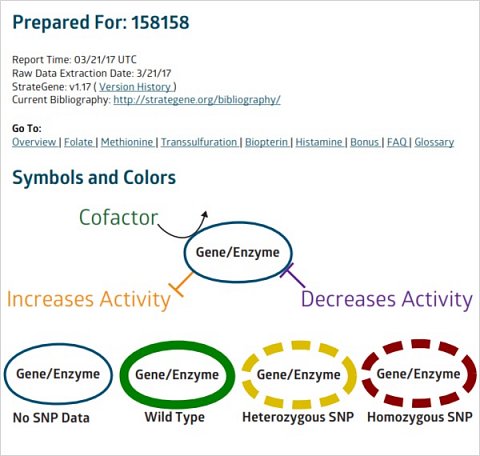
The front page of my report.
It was immediately made clear that the report should not be used alone as a form of diagnosis or to decide on any treatments. The date that the report was generated was included at the top, which reassured me that it really was an analysis of my data, not just a generic report sent to everyone. There was also a link to their most recent bibliography, which included a categorized list of peer-reviewed articles that the report was based on. I was really impressed with this information, especially as I noticed that some of the papers had only recently been published.
The report itself started with a key to the colors and symbols that would be used, underneath a hyperlinked list of contents of the sections that the results were sorted into: ‘Overview’, ‘Folate’, ‘Methionine’, ‘Transsulfuration’, ‘Biopterin’, ‘Histamine’, ‘Bonus’, ‘FAQ’ and ‘Glossary’.
Results section: Overview
The first section of the report was a summary of all of my results, displayed in two tables - one for the core SNPs and one for the bonus SNPs. The core table is shown below.
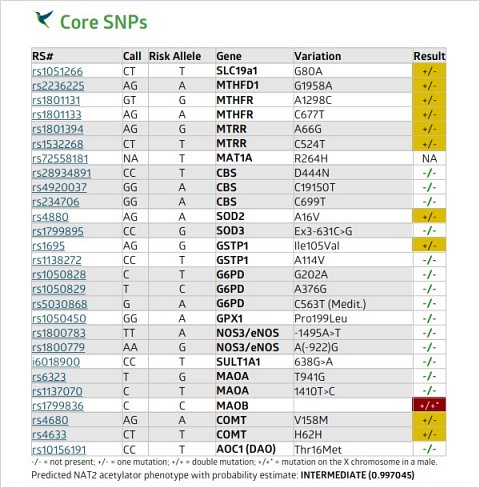
The overview of results for my core SNPs.
This table confused me a little. I wasn’t sure what RS# meant and the rest of the table consequently made little sense. A Google search revealed that this was a number used to identify different SNPs (genetic variants/polymorphisms). I also realized that by clicking on them, I was taken to the relevant pathway, which was a feature that I imagine is really useful if you’re interested in specific SNPs. I assumed that the ‘+’ and ‘-‘ results were colored red or yellow depending on whether they were good or bad, but couldn’t be sure. As there was no explanation, I moved on to the next part of the report.
Results section: Folate
I moved on to the main part of the report, which was made up of the various biochemical pathways that help control certain processes in the body, and the genes involved in them. The first of these pathways was the folate cycle, and the section started with a short explanation of what the pathway’s role was in the body. I felt that this was a good way to start the section, but found it a little too complex, and unfortunately didn’t feel I fully understood why the folate cycle was so important.
This explanation was followed by a diagram showing the pathway itself (shown below).
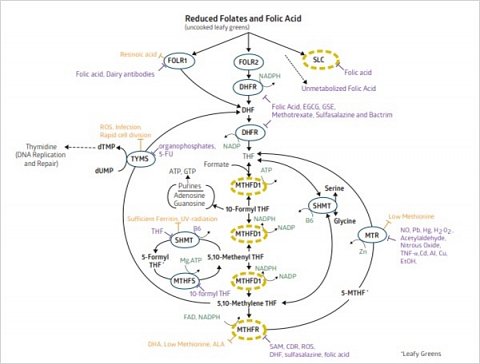
My personalized folate cycle diagram.
This diagram was made up of several arrows and different colored symbols with random letters inside. I referred to the key at the beginning of the report to try and make some sense of these. This itself included words that I didn’t really understand and which weren’t explained, such as ‘enzyme’ and ‘co-factor’. I looked up what an enzyme was, as it seemed to be a big part of the diagrams. I found out that an it’s basically something that acts as a catalyst for reactions that happen in our body. Other words which I didn’t understand were ‘heterozygous’ and ‘homozygous’. Looking these terms up revealed that ‘heterozygous’ was the word used when there were two different copies of the same gene as opposed to two of the same copy (homozygous).
Once I understood the terms used in the key, it became a bit easier to interpret the diagram, and I realized that they had been personalized to show which versions of the gene I had, which was quite cool.
The second part of this section explained more about what the different versions of the genes might mean clinically. Each folate cycle-related gene that had been analyzed was listed, along with information about what my particular variant’s impact might be on the cycle and what it might mean for my health. A part of it is shown below.
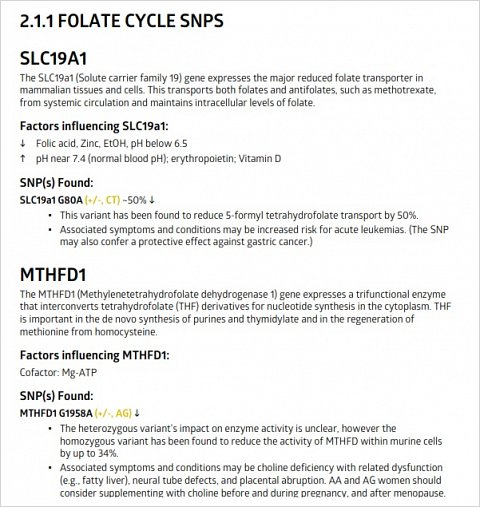
The explanation of my folate cycle results.
This section was a little easier to understand than the previous ones in terms of the technical language, but there were still parts that were too complex for me to get my head around. For example, one result in this section suggested that my variants might increase my chances of getting certain types of leukemia, which was clear and straightforward. Conversely, the same section described how it was also linked to a 50% decrease in 5-formyl tetrahydrofolate transportation, which was not explained at all.
Results section: Other pathways
Each of the other pathway sections had a similar structure to the folate cycle section, but focused instead on the methionine, transsulfuration, biopterin and histamine pathways. Once I had gotten my head around the folate diagram, these became a lot easier to understand and I found it quite interesting to look through each and see where my different genetic variants fitted in. The explanations continued to be a bit too complex for me to interpret with ease, but one thing I found more interesting in these sections was a list of environmental factors that influenced these genes. They included some quite obvious factors, such as smoking, but also less obvious ones, such as foods that include certain chemicals (eg. aged cheeses apparently contain something called Tyramine).
Results section: Bonus SNPs, FAQs and Glossary
The rest of the report was made up of results for the bonus SNPs, frequently asked questions, and a glossary. The bonus SNP section was similar to the previous ones but the results weren’t accompanied by diagrams of the relevant biochemical pathways. A section of it is shown below:
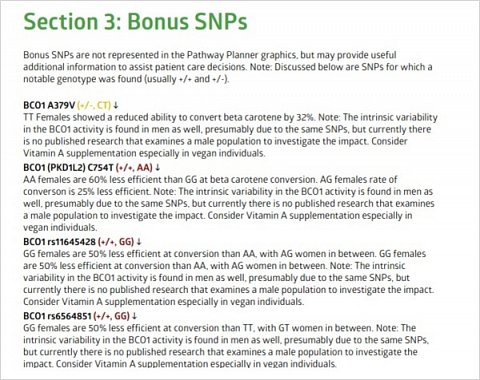
A section of my ‘Bonus SNPs’ results.
I was a bit disappointed to see that many of these results only had evidence for women, so weren’t relevant to me. However, there were quite a few easily implementable recommendations in this section, particularly to consider Vitamin A supplementation. I found this useful, though there was also less specific advice such as considering ‘healthy sleep patterns’, ‘moderate exercise’ and ‘avoidance of smoking, alcohol, lead’, which I felt were common-sense suggestions rather than ones based specifically on my genetic analysis.
The FAQs and Glossary weren’t actually included in the report itself, but were links to external pages. This again reassured me that StrateGene were continuously updating their research and therefore the analysis they provided. I felt that it was a shame that some of the words that had caused me confusion weren’t included in the glossary. Instead it included a list of the long versions of the many acronyms used in the report, which I guessed would be useful for further researching my results to try and understand them more fully.
The FAQs were interesting, but didn’t really answer the main questions I had about the report. There was a whole section dedicated to clinician’s questions, which further convinced me that the report was better suited to medical professionals than the general public.
Summary
In summary, whilst I can see that this report had many merits, particularly in its detail, supporting evidence and excellent diagrams, I felt that it was a bit too complex to be of real use. I’d recommend this test to those who have a keen interest in the scientific analysis involved in DNA testing, rather than to those who would prefer easily understandable results and readily implementable recommendations. The report definitely provided extra information about my 23andMe data and gave me a lot of good starting points from which to base further research. This said, in general I think this report is much better suited to those with a medical or scientific background than consumers.


